|
|
|
ABSTRACT:
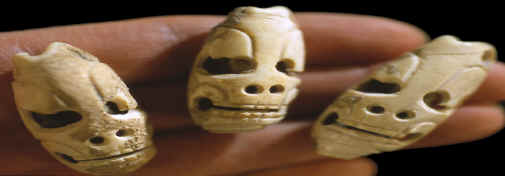
MAYAN MARINE
SHELL TINKLERS
BELIZE
OR GUATEMALA
PRIVATE
COLLECTION
This article illustrates and describes four Oliva marine shell tinkler beads that are
believed to be from either Belize of Guatemala. They are carved in
the shape of a death head design or skulls. |
|
|
"Oliva
tinklers are a widespread Maya lowland & Mesoamerican trait"-1946,
Kidder, Jennings & Shook, pp. 148-149.
"Tinklers
are little spiral univalves, either Oliva sp., of which we have 16 or
Jenneria pustulata, of which we have 39"--1972,
"The Artifacts of Altar De Sacrificios," by Gordon R. Willey,
pp. 220-223.
|
|
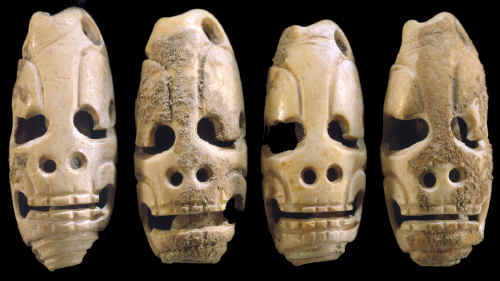
CLICK ON
PICTURE FOR LARGE IMAGE
MAYAN MARINE SHELL TINKLERS
LATE PRECLASSIC TO LATE
CLASSIC PERIOD
BELIZE OR GUATEMALA
PRIVATE COLLECTION
These four "death head" marine Oliva shell tinklers were
probably suspended around the neck, possibly with other beads on a
necklace. They were all drilled on both sides at the top and a
portion of the spiral on the bottom was ground or cut away. The
largest shell in this group measures 1 15/16 inches (4.9 cm) long. |
|
|
The images
on these four engraved tinklers are strong and very well done. They were
probably carved by one of the many skilled craftsmen that were working
within the Mayan Classic or Postclassic periods sometime before A.D. 1200.
A few examples that appear to be similar in design, but were carved in jade,
were found on the Maya city of Rio Azul
in northern Guatemala. They are illustrated on page 432 in the April 1986 issue
of National Geographic magazine. They appear to be drilled through
vertically and also drilled on both sides of the top end like these
examples.
|
|
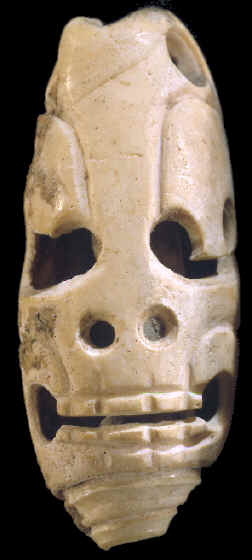 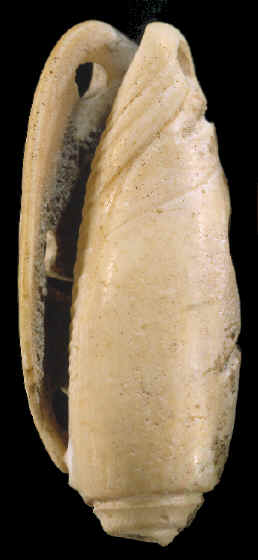
MAYAN MARINE SHELL
TINKLERS
PRECLASSIC---POSTCLASSIC PERIODS
BELIZE OR GUATEMALA
PRIVATE COLLECTION
This is the largest of the four shell tinklers in this collection. One curious thing is
that all the holes for the right nostrils are slightly higher than
the left ones. |
|
|
Gordon
R. Willey (1972) describes tinklers as "little spiral
univalves." This is in reference to 55 (unengraved) examples that
they found while excavating on the Altar de Sacrificios site in
Guatemala in the 1960's. They were made from both Oliva sp. and Jenneria
pustulata marine shells. They found these examples in both refuse and
with burials and they were dated from the Late Preclassic Period to the
Late Classic Period (A.D. 100 to A.D. 900). Willey (1972) also writes
that "Oliva shell tinklers or beads are common to the Maya lowland
sites and that they seem to be met with more frequently in Late Classic
levels."
|
|
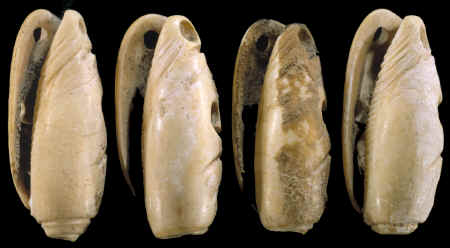
CLICK ON
PICTURE FOR LARGE IMAGE
MAYAN MARINE SHELL TINKLERS
CLASSIC OR POSTCLASSIC PERIOD
BELIZE OR GUATEMALA
PRIVATE COLLECTION
This picture shows the back of the four marine Oliva shell tinklers.
A couple of them have quite a lot of encrusted patination. One end
of the shells are drilled on both sides for suspension and the spirals
on the bottom have been cut or ground away. |
|
|
There is no
doubt that the Maya were master artists. Their art was sustained for
hundreds of years by a society that was able to support an
infrastructure of highly skilled craftsmen. Many of the images they placed
on plastered walls, carved stones, bone, ceramics or shell are powerful.
These marine shell tinklers are no exception.
|
|
"REFERENCES"
1965, "Prehistoric Maya Settlements in the Belize Valley," by
Gordon R. Willey, William R. Bullard, john B. Glass & James C. Gifford,
pp. 505-508.
1972,
"The Artifacts of Altar De Sacrificios," by Gordon R. Willey,
pp. 220-223.
1986, "Rio Azul," National Geographic, April. 1986, by
Richard E. W. Adams, p. 432.
|
|
HOME
ORDERING |